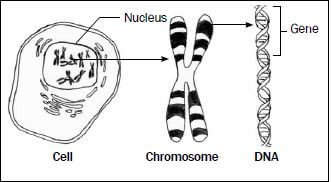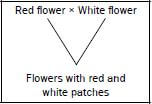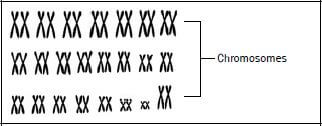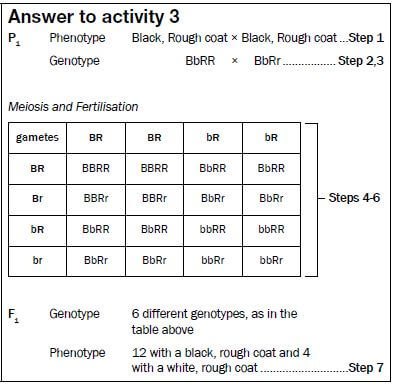GENETICS GRADE 12 NOTES - LIFE SCIENCES STUDY GUIDES
Share via Whatsapp Join our WhatsApp Group Join our Telegram GroupGENETICS
LIFE SCIENCES
STUDY GUIDES AND NOTES
GRADE 12
- Key concepts
- Activity 1
- Genetic crosses
- Mutations
- Pedigree diagrams
- Activity 4
- Genetic engineering
- Activity 5
- Genetic counselling
- Activity 6
CHAPTER 5: GENETICS
5.1 Key concepts
Make mobile notes (see instructions on page x) to learn these key concepts.
Term | Explanation | Diagram/Additional notes |
Gene | A small portion of DNA coding for a particular characteristic. |
|
Alleles | Different forms of a gene which occur at the same locus (position) on homologous chromosomes. | 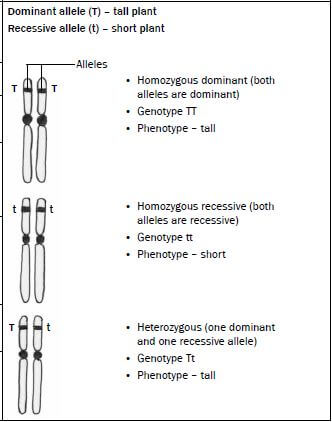 |
Genotype | Genetic composition (make-up) of an organism. | |
Phenotype | The physical appearance of an organism determined by the genotype, e.g. tall, short. | |
Dominant allele | An allele that is expressed (shown) in the phenotype when found in the heterozygous (Tt) and homozygous (TT) condition. | |
Recessive allele | An allele that is masked (not shown) in the phenotype when found in the heterozygous (Tt) condition. | |
Heterozygous | Two different alleles for a particular characteristic, e.g. Tt. | |
Homozygous | Two identical alleles for a particular characteristic, e.g. TT or tt. |
Term | Explanation | Diagram/Additional notes | |
Monohybrid cross | Only one characteristic or trait is being shown in the genetic cross. | Example: Flower colour only, e.g. yellow flower or white flower or shape of seeds only, e.g. round seeds or wrinkled seeds. | |
Complete dominance | A genetic cross where the dominant allele masks (blocks) the expression of a recessive allele in the heterozygous condition. | In this type of cross the allele for tall (T) is dominant over the allele for short (t). The offspring will therefore be tall because the dominant allele (T) masks the expression of the recessive allele (t). | 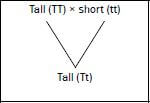 |
Incomplete dominance | A genetic cross between two phenotypically different parents produces offspring different from both parents but with an intermediate phenotype. | Example: If a red-flowered plant is crossed with a white-flowered plant and there is incomplete dominance - the offspring will have pink flowers (intermediate colour). |
|
Co-dominance | A genetic cross in which both alleles are expressed equally in the phenotype. | Example: If a red-flowered plant is crossed with a white-flowered plant and there is co-dominance the offspring has flowers with red and white patches. |
|
Multiple alleles | More than two alternative forms of a gene at the same locus. | Example: Blood groups are controlled by three alleles, namely IA, IB and i. | |
Sex-linked characteristics | Characteristics or traits that are carried on the sex chromosomes. | Examples: Haemophilia and colour-blindness The alleles for haemophilia (or colour-blindness) are indicated as superscripts on the sex chromosomes, e.g. XHXH (normal female), XHXh (normal female), XhXh (female with haemophilia), XHY (normal male), XhY (male with haemophilia). | |
Karyotype | The number, shape and arrangement of all the chromosomes in the nucleus of a somatic cell. |
| |
Cloning | Process by which genetically identical organisms are formed using biotechnology. | Example: Dolly the sheep was cloned using a diploid cell from one parent; therefore it had the identical genetic material of that parent. | |
Genetic modification | The manipulation of the genetic material of an organism to get desired changes. | Example: The insertion of human insulin gene in plasmid of bacteria so that the bacteria produce human insulin. | |
Human genome | The mapping of the exact position of all the genes in all the chromosomes of a human. | Example: Gene number 3 on chromosome number 4 is responsible for a particular characteristic. | |
Activity 1
Choose an item from COLUMN 2 that matches a description in COLUMN 1.
Write only the letter (A to I) next to the question number (1-5), for example 6. J.
| COLUMN 1 | COLUMN 2 |
| A. Gene B. Recessive C. Haemophilia D. Dominant E. Homologous F. Genotype G. Phenotype H. Alleles I. Karyotype |
[5]
Answers to activity 1
- B✔
- H✔
- C✔
- E✔
- G✔ (5 × 1) [5]
5.2 Genetic crosses
Use the following genetic problem format or template to solve all monohybrid genetic problems: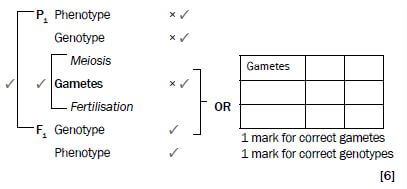
- The problem on the next page shows that a cross between a heterozygous parent (Tt) and a homozygous recessive (tt) parent produces F1 offspring that are 50% heterozygous (Tt) and 50% homozygous recessive (tt).
- A cross between a homozygous dominant (TT) parent and a homozygous recessive (tt) parent produces F1 offspring that are 100% heterozygous (Tt).
- A cross between a homozygous dominant (TT) and a heterozygous (Tt) parent produces F1 offspring that are 50% homozygous dominant (TT) and 50% heterozygous (Tt).
- A cross between two heterozygous (Tt) parents produces F1 offspring that are 25% homozygous dominant (TT), 50% heterozygous (Tt) and 25% homozygous recessive (tt).
5.2.1 Complete dominance
This refers to a genetic cross where the dominant allele masks (blocks) the expression of a recessive allele in the heterozygous condition.
The following problem represents a genetic cross which shows complete dominance:
e.g. Genetic problem 1
In humans the ability to roll the tongue is due to a dominant allele. A man who is heterozygous for tongue-rolling and a woman who cannot roll her tongue have children.
Use the symbols T and t for the alleles of the tongue-rolling characteristic and represent a genetic cross to determine the possible genotypes and phenotypes of the children. (6)
Read the problem carefully and note the following steps:
- Identify the phenotypes of the man and the woman (parents/P1), i.e. the man is a tongue-roller and the woman is a non-tongue-roller Step 1
- Identify the genotypes of the two parents, i.e. the man is heterozygous (Tt) and the woman can only be a non-tongue-roller if she is homozygous recessive for this characteristic, i.e. she must have the genotype (tt) Step 2
- The next step is to show how the alleles are separated through the process of meiosis into separate gametes, i.e. in the man the gametes (sperm) will contain either the ‘T’ allele or the ‘t’ allele.In the woman the egg can only contain the ‘t’ allele Step 3
- The next step shows that fertilisation takes place. Indicate all possible combinations of how sperm cells fuse with a possible egg cell to show the possible genotypes of the F1 generation that could arise Step 4
- Interpret the phenotypes of all the possible genotypes from the cross Step 5
Solution to genetic problem 1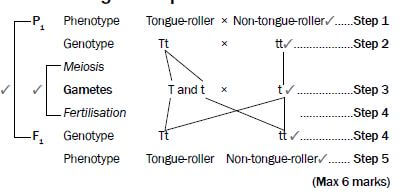
5.2.2 Incomplete dominance
This refers to a genetic cross between two phenotypically different parents producing an offspring different from both parents but with an intermediate phenotype. The following problem represents a genetic cross that shows incomplete dominance.
e.g. Genetic problem 2
A homozygous snapdragon plant with red flowers (R) was cross-pollinated with a homozygous snapdragon plant with white (W) flowers. All the plants that grew from the cross had pink flowers. Represent a genetic cross to show the possible genotypes and phenotypes of the F1 generation of plants.
Solution to genetic problem 2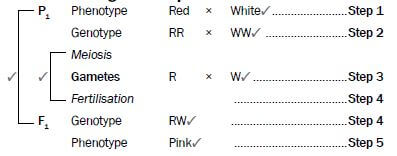
5.2.3 Co-dominance
This refers to a genetic cross in which both alleles are equally expressed in the phenotype.
The following problem represents a genetic cross which shows co- dominance.
e.g. Genetic problem 3
A plant with white flowers was cross-pollinated with a plant with red flowers. All the plants that grew from the cross had flowers with equal distribution of red and white colour. Represent a genetic cross to show the possible genotypes and phenotypes of the F1 generation of plants.
Solution to genetic problem 3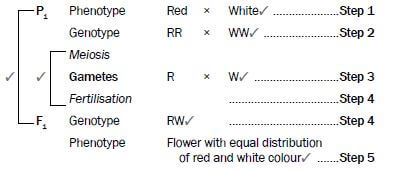
5.2.4 Inheritance of sex
The following problem represents a genetic cross which shows inheritance of sex.
e.g. Genetic problem 4
A couple has three sons and the woman is pregnant again. Show diagrammatically by means of a genetic cross what the percentage chance is of the couple having a baby
girl.
Solution to genetic problem 4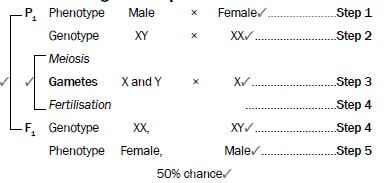
5.2.5 Inheritance of sex-linked characteristics
Sex-linked characteristics are characteristics (traits) that are carried on the sex chromosomes.
The following problem represents a genetic cross which shows the inheritance of sex-linked characteristics.
e.g. Genetic problem 5
Haemophilia is a sex-linked hereditary disease that occurs as a result of a recessive allele on the X-chromosome (Xh). A normal father and heterozygous normal mother have children. Represent a genetic cross to determine the possible genotypes and phenotypes of their children.
The alleles for haemophilia are indicated as superscripts on the sex chromosomes,
e.g. XHXH (normal female), XHXh (carrier/heterozygous normal female), XhXh (female with haemophilia), XHY (normal male), XhY (male with haemophilia).
Solution to genetic problem 5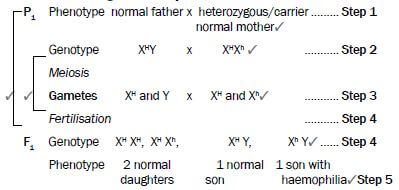
Activity 2
Question 1
Try solving this problem on your own before you look at the solution.
Fur colour in mice is controlled by a gene with two alleles. A homozygous mouse with black fur was crossed with a homozygous mouse with brown fur. All offspring had black fur. Using the symbols B and b to represent the two alleles for fur colour, show diagrammatically a genetic cross between a mouse that is heterozygous for fur colour and a mouse with brown fur. Show the possible genotypes and phenotypes of the offspring. (6)
Question 2
In rabbits the dominant allele (B) produces black fur and the recessive allele (b) produces white fur. Use a genetic cross to show the possible phenotypes and genotypes of the F1 generation for fur colour if two heterozygous rabbits are crossed. (6)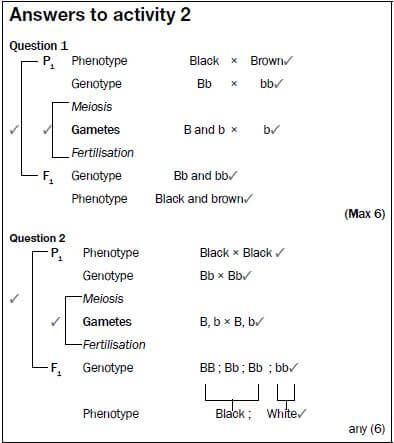
5.2.6 Dihybrid cross
- A dihybrid cross involves the inheritance of two characteristics. Mendel explained the results obtained from dihybrid crosses according to his Law of Independent Assortment.
- According to the Law of Independent Assortment, alleles of a gene for one characteristic segregate independently of the alleles of a gene for another characteristic. The alleles for the two genes will therefore come together randomly during gamete formation.
- This means that the two characteristics are transmitted to the offspring independently of one another.
- The above law only applies if the genes for the two characteristics are not on the same chromosome.
Steps you should follow in working out a dihybrid cross:
e.g. Example
In pea plants, the allele for tallness (T) is dominant and the allele for shortness (t) is recessive. The allele for purple flowers is dominant (P) and the allele for white flowers is recessive (p). Two plants, heterozygous for both tallness and purple flowers, were crossed.
STEP | What to do generally | What to do in this problem | |||||||||
Step 1 | Identify the phenotypes of the two plants for each of the two characteristics. | According to the statement of the problem, both parents are tall and have purple flowers. | |||||||||
Step 2 | Choose letters to represent the alleles for the gene responsible for each characteristic. | Use the letters, e.g. T for tall, t for short, P for purple, and p for white as provided in the question. | |||||||||
Step 3 | Write the genotypes of each parent. | According to the statement of the problem, both parents are heterozygous for each characteristic. Their genotype will therefore be TtPp. | |||||||||
Step 4 |
|
| |||||||||
Step 5 | Enter the possible gametes at the top and side of a Punnett square. | Please refer to the solution that follows. |
Step 6 |
| Please refer to the solution that follows. |
Step 7 | Determine the phenotypes of the offspring from the genotypes obtained in the punnet square. | Please refer to the solution that follows. |
Solution to the problem
P1 Phenotype Tall, Purple × Tall, Purple................... Step 1
Genotype TtPp × TtPp......................... Step 2,3
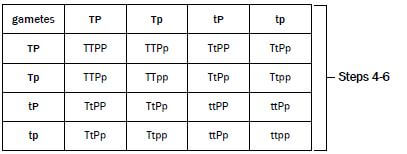
F1 Genotype 9 different genotypes, as in the table above
Phenotype 9 tall, purple flowered plants (T-P-);
3 short, purple flowered plants (ttP-);
3 tall, white flowered plants (T-pp), and
1 short, white flowered plant (ttpp) . Step 7
Activity 3
Question
In hamsters, the allele for black coat colour (B) is dominant over the allele for white coat colour (b). The allele for rough coat (R) is dominant over the allele for smooth coat (r). If you cross a hamster that is heterozygous black and homozygous rough, with one that is heterozygous black and heterozygous rough, what will be the phenotypes and genotypes of the offspring? (Use the steps 1-7 to arrive at an answer).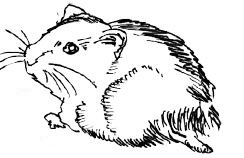

5.3 Mutations
A mutation is any sudden unexpected change in the genetic structure of a cell. Mutations occur suddenly and randomly and may be caused by many environmental agents such as X-rays and certain chemicals.
Mutations may be harmful or harmless to the organism in which they occur. Harmful mutations cause changes in DNA that can cause errors in protein sequencing, that can result in partially or completely non-functional proteins. Harmless mutations have no effect on the structure or functioning of the organism. Useful mutations can be advantageous to the organism and they are passed on from parent to offspring.
Gene mutations are mutations that affect a single or a few base pairs in just a single gene, while Chromosomal aberrations refer to changes in the normal structure or number of chromosomes.
Mutations result in new genotypes as we move from one generation to the next. This leads to variation within a species.
Gene mutations can cause genetic disorders:
- Haemophilia: Absence of the protein needed for the formation of blood clots due to a mutant gene.
- Colour blindness: Absence of the proteins that make up either the red or green cones/photoreceptors in the eye.
- Albinism: Absence of the protein that forms the pigment melanin.
Chromosomal aberrations e.g. Down syndrome is where there is an extra chromosome (47 instead of 46) in the zygote.
5.4 Pedigree diagrams
A pedigree diagram is used to study the inheritance of characteristics in a family over a number of generations. A pedigree diagram is also called a family tree.
Remember the following steps when interpreting pedigree diagrams:
Step 1 Study any key and opening statement/s and look for dominant and recessive characteristics and phenotypes.
Step 2 Write in the phenotypes of all the individuals as given in the problem.
Step 3 Fill in the genotype of all the individuals with the recessive condition - it must have two recessive alleles (two lower case letters, e.g. ff).
Step 4 For every individual in the diagram that has the recessive condition, it means that each allele was obtained from each of the parents. Work backwards and fill in one recessive allele for each parent.
Step 5 If the parents showed the dominant characteristic, fill in the second letter which represents the dominant allele (a capital letter, e.g. F).
Step 6 Any other individual showing the dominant characteristic will most likely be homozygous dominant (FF) or heterozygous dominant (Ff).
Activity 4
The pedigree diagram in Figure 5.1 shows inheritance of eye colour in humans over three generations of a family. Brown eye colour (B) is dominant over blue eye colour (b). Study the diagram and then answer the questions that follow.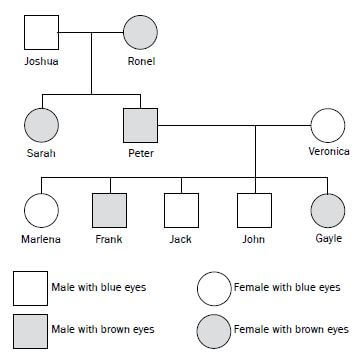
Figure 5.1 Pedigree diagram showing inheritance of eye colour
Note the following in the pedigree diagram on page 38:
- Squares represent males and circles represent females.
- The horizontal line between a square (Joshua) and a circle (Ronel) shows that they have mated.
- The vertical line flowing from the horizontal line represents the offspring (Sarah and Peter) of the two parents (Joshua and Ronel).
- Brown eye colour (B) is dominant over blue eye colour (b) - stated in problem Step 1
- Joshua, Jack and John are males with blue eyes.
- Veronica and Marlena are females with blue eyes.
- Peter and Frank are males with brown eyes. Step 2
- Ronel, Sarah and Gayle are females with brown eyes.
- Joshua, Veronica, Marlena, Jack and John will have the genotype ‘bb’. The recessive characteristic only shows up in the homozygous condition Step 3
- Example: The genotype of Peter is ‘Bb’ - working backwards from the offspring Marlena or Jack or John who are homozygous recessive.
This means that one of the recessive alleles of Marlena, Jack and John, i.e. ‘b’, must have come from parent Peter and the other one from parent Veronica Steps 4 and 5 - Ronel could be homozygous dominant (BB) or heterozygous dominant (Bb) Step 6
Questions
1. How many members of the family have blue eyes? (1)
2. Is Veronica homozygous or heterozygous for eye colour? (1)
3. Write down the genotype of:
a) Joshua (2)
b) Ronel (2)
c) Frank (2)
4. If Frank marries a woman with the same genetic composition as Sarah, what is the percentage probability of them having a child with brown eyes? (1) [9]
Answers to activity 4
1. 5✔ (1)
2. Homozygous✔(1)
3. a) bb✔✔ (2)
b) BB/Bb✔✔ (2)
c) Bb✔✔ (2)
4. 75%✔
5.5 Genetic engineering
Genetic engineering is the process whereby the genes on the DNA are changed, transferred or manipulated to produce a different organism.
Activity 5
Question
State FOUR disadvantages and FOUR advantages of genetic engineering. [8]
Answer to activity 5
Four disadvantages of genetic engineering:
- Expensive✔/research money could be used for other needs
- Interfering with nature✔/immoral
- Potential health impacts✔
- Unsure of long-term effects✔ (4)
Four advantages of genetic engineering:
- Production of medication/resources cheaply✔
- Control pests with specific genes inserted into a crop✔
- Using specific genes to increase crop yields✔/food security
- Selecting genes to increase shelf-life of plant products✔ (4) [8]
5.6 Genetic counselling
Couples with a risk of a genetic disease can undergo genetic counselling to enable them to make informed decisions on whether they want to have children or not.
Activity 6
Question
A young couple wants to have a child, but they are aware of a serious genetic disorder in one of their families that could be carried through to their offspring. State THREE benefits of genetic counselling in this case. [3]
Answer to activity 6
Three benefits of genetic counselling:
- To be given advice on the risk of transferring the defective gene✔/ to find the probability of passing on the defective gene to the offspring
- To be given an explanation of the procedure involved in DNA testing✔
- To be given an explanation of the results of DNA testing✔ [3]
